Notes on Machine Learning 7: Bayesian Inference
by 장승환
(ML 7.1) Bayesian inference - A simple example
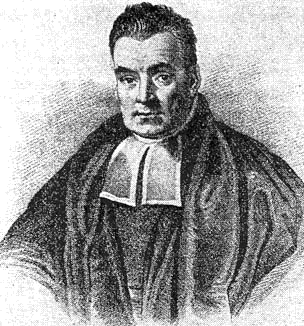
“Put distributions on everything, and then use rules of probability!”
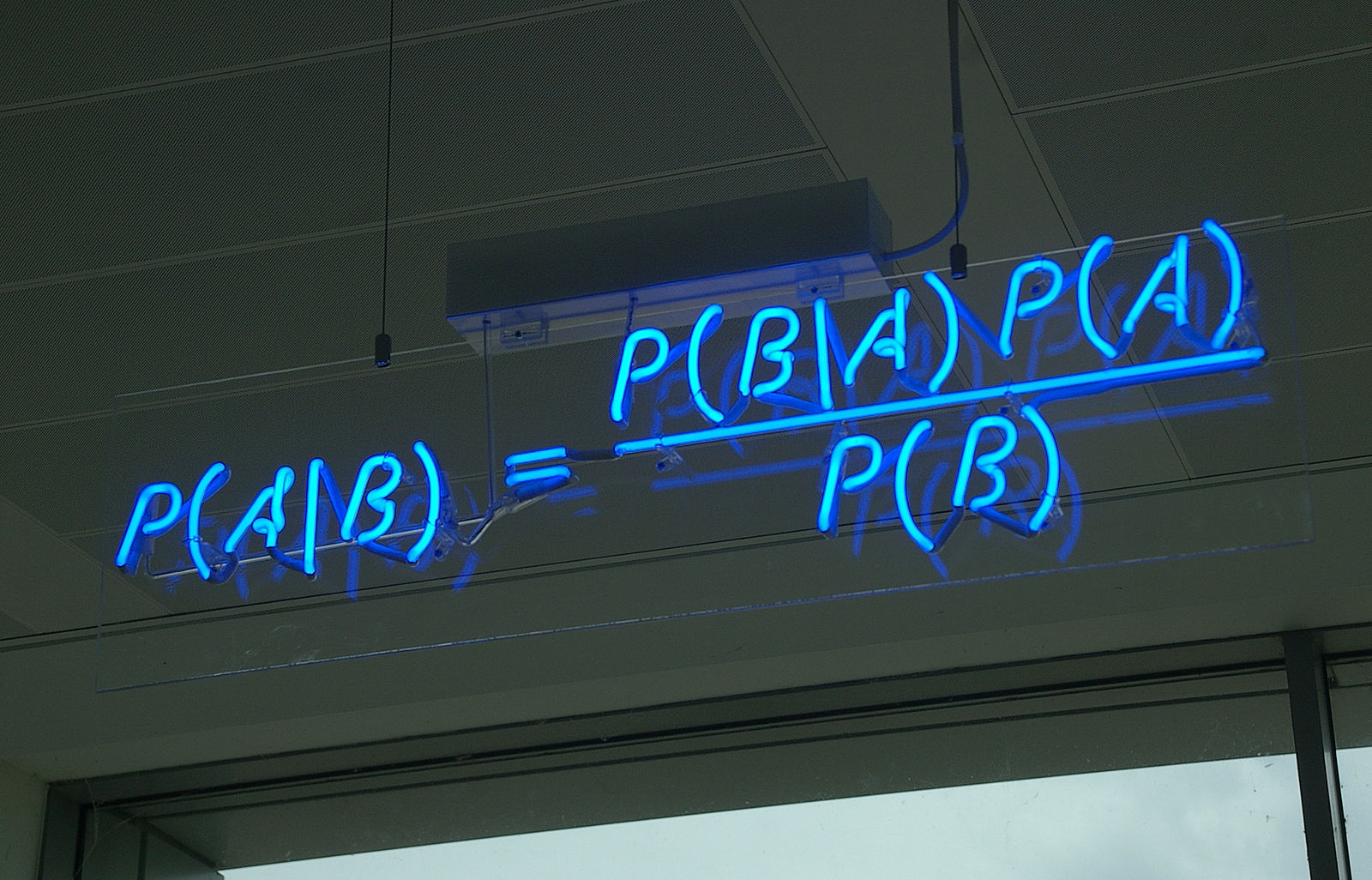
Exampl.
$D= (x_1, x_2, x_2) = (101, 100.5, 101.5)$ ($n=3$)
$X \sim N(\theta, 1)$ iid given $\theta$
$\theta_{\rm MLE} = \overline{x} = \frac{1}{n}\sum_{i=1}^n = 101$
$ $
$\theta = N(100,1)$ prior
$\theta_{\rm MAP} = 100.75$
To compute $P(\theta < 100 \vert D)$, one needs posterior $p(\theta \vert D)$
posterior:
$p(\theta \vert D) = \frac{p(D\vert \theta)p(\theta)}{p(D)} = \frac{\prod_{i=1}^np(x_i \vert \theta) p(\theta)}{p(D)}$
$\leadsto$ can be desribed as a normal distribution and so analytically computable!
predictive:
$p(x \vert D) = \int p(x, \theta \vert D) d \theta = \int p(x\vert\theta)p(\theta \vert D) d \theta$
$\leadsto$ analytically integrable!
(ML 7.2) Aspects of Bayesian inference
- Bayesian inference : Assume a prior distribution $p(\theta)$ and then use probability rules to work with $p(x\vert \theta)$ to anser questions.
-
Bayesian procedures : Minimize expected loss (averaging over $\theta$).
- Objective Bayesian : use belief-based priors
- Subjective Bayesian : use non-informative priors
Pros.
- Directly answer certain questions, e.g., can compute $P(99 < \theta < 101)$
- Avoid some pathologies (associated with frequentist approach)
- Avoid overfitting
- Automatically do medel selection (“Occam’s razor”)
- Bayesian procedures are often admissible
Cons.
- Must assume a prior
- Exact computation (of posterior) can be intractable ($\leadsto$ have to use approximation)
Priors.
- Non-informative
- Improper, e.g., $p(\theta) = 1$ with density
- Conjugate
(ML 7.3) Proportionality
“Using proportionality is a extraordinarily handy trick (big time-saver) when doing Bayesian inference.”
Notation. $f \propto g$ if there exists $c \neq 0$ such that $g(x) = cf(x)$ for all $x$.
Claim. If $f$ is a PDF and $f \propto g$ then $g$ uniquely determine $f$, and $f(x) = \frac{g(x)}{\int g(x)}dx$.
Proof. $\frac{g(x)}{\int g(x)}dx = \frac{cf(x)}{\int cf(x)}dx = f(x)$.
(ML 7.4) Conjugate priors
Definition. A family $\mathscr{F}$ of (prior) distributions $p(\theta)$ is conjugate to a likelihood $p(D\vert \theta)$ if the posterior $p(\theta \vert D)$ is in $\mathscr{F}$.
Examples.
- Beta is conjugate to Bernoulli.
- Gaussian is conjugate to Gaussian (mean).
- Any exponential family has a conjugate prior.
(ML 7.5) (ML 7.6) Beta-Bernoulli model
For example, we model a sequence of binary outcomes, like coin flips, as Bernoulli random variables with Beta prior distribution on the probability of the heads. In other words, Beta is a conjugate prior for Bernoulli.
Setup: $X_1, \ldots, X_n \sim {\rm Bern}(\theta)$ independen gieven $\theta$ with prior $\theta \sim {\rm Beta}(a,b)$.
Here the parameters $a, b$ of the prior are called hyperparameters.
For generaic $X \sim {\rm Bern}(\theta)$, we have
where
From the setup we generate data $D = (x_1, \ldots, x_n)$. Then it’s easy to compute the posterior distribution:
where $n_1 := \sum I(x_i=1)$ and $n_0 := \sum I(x_i=0)$.
Thus, $p(\theta\vert D) = {\rm Beta}(\theta\vert a+n_1, b+n_0)$, and so Beta is conjugate to Bernoulli.

See Beta distribution - an introduction by Ox educ for intuition behind Beta prior.
If $\theta \sim {\rm Beta}(a, b)$, one has:
- $\mathbb{E}(\theta) = \frac{a}{a+b}$;
- $\sigma^2(\theta) = \frac{ab}{(a+b)^2(a+b+1)}$;
- mode $=\frac{a-1}{a+b-2}$.
($a+n_1, b+n_0$ are called pseudocounts)
For $\theta \vert D \sim {\rm Beta}(\theta\vert a+n_1, b+n_0)$, on has:
- $\mathbb{E}(\theta\vert D) = \frac{a+n_1}{a+b+n}$;
- mode $=\frac{a+n_1-1}{a+b+n-2}$.
Now let’s make a few connections. We know that
- $\theta_{\rm MLE} =$ empirical probability $= \frac{n_1}{n}$ / $\left(\frac{n_0}{n}, \frac{n_1}{n}\right)$
- $\theta_{\rm MAP} = \frac{a+n_1-1}{a+b+n-2}$
posterior mean $=\frac{a+n_1}{a+b+n} = \frac{a+b}{a+b+n}\cdot \frac{a}{a+b} + \frac{n}{a+b+n}\cdot \frac{n_1}{n}$,
i.e., a convex combination of prior mean & MLE
- When $n \rightarrow \infty$, posterior mean convergees to the MLE.
- When $n = 0$, if we have no data, we get back to the prior mean.
Let’s compute now the (posterior) predictive distribution:
(ML 7.7.A1) Dirichlet distribution
Dirichlet, one of the great mathematicians in 1800s.
Dirichlet distribution is a distribution on probability distributinos.
$\theta = (\theta_1, \ldots, \theta_n) \sim {\rm Dir}(\alpha)$ means:
where $\alpha = (\alpha_1, \ldots, \alpha_n)$, $\alpha_i >0$ are the parameters, $S = \{x \in \mathbb{R}^n: x_i \ge 0, \sum_{i=1}^n x_n =1 \}$ is the probability simplex, and $\frac{1}{B(\alpha)} =\frac{\Gamma(\alpha_0)}{\Gamma(\alpha_1)\cdots\Gamma(\alpha_n)}$.
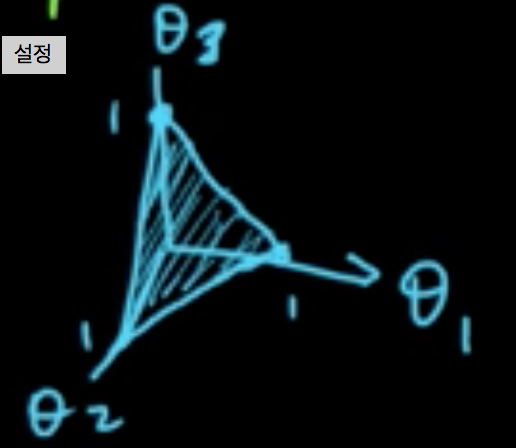

$E(\theta_i) = \frac{\alpha_i}{\alpha_0}$
${\rm mode} = \left(\frac{\alpha_1-1}{\alpha_0}, \ldots, \frac{\alpha_n-1}{\alpha_0-n}\right)$
$\sigma^2(\theta) = \frac{\alpha_i(\alpha_0-\alpha_i)}{\alpha_0^2(\alpha_0+1)}$
(7.8)
(ML 7.9) (ML 7.10) Posterior distribution for univariate Gaussian
Given data $D = (x_1, \ldots, x_n)$ with $x_i \in \mathbb{R}$,
want to know from which distribution $D$ might come fomm.
Model $D$ as $X_1, \ldots, X_n \sim N(\mu, \sigma^2)$ for some $\mu, \sigma \in \mathbb{R}$,
i.e., $N(\mu, \sigma^2)$ is the “true” distribution wa want.
Becasue we do not know $\mu$, we model it as a random variable $\theta$, which itself follows a normal distribution:
We assume that $\sigma^2, \mu_0, \sigma_0^2$ are known to make the problem (more) tractable.
Then the postesior distribution is given by
Now,
We have:
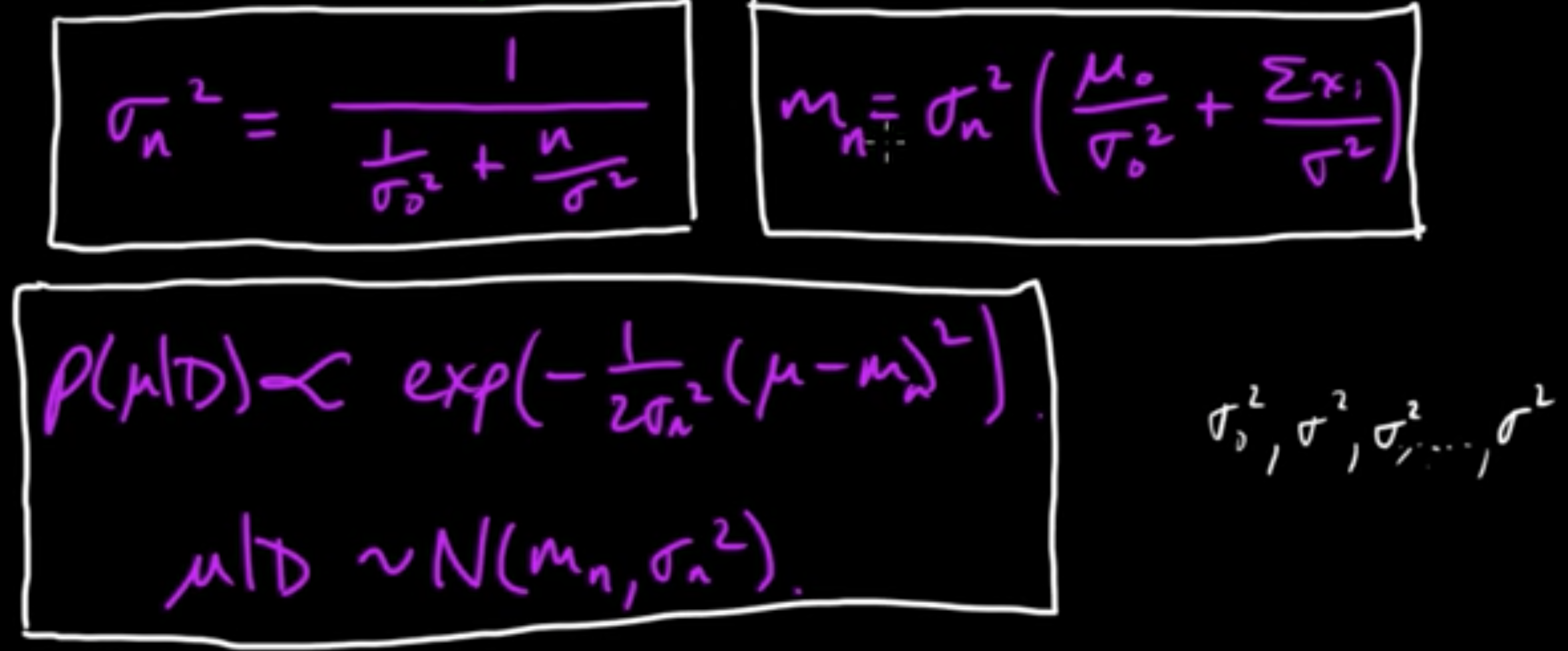
and
with
The convergence behavior of the posterior mean (MAP) when $n$ approaches $\infty$:
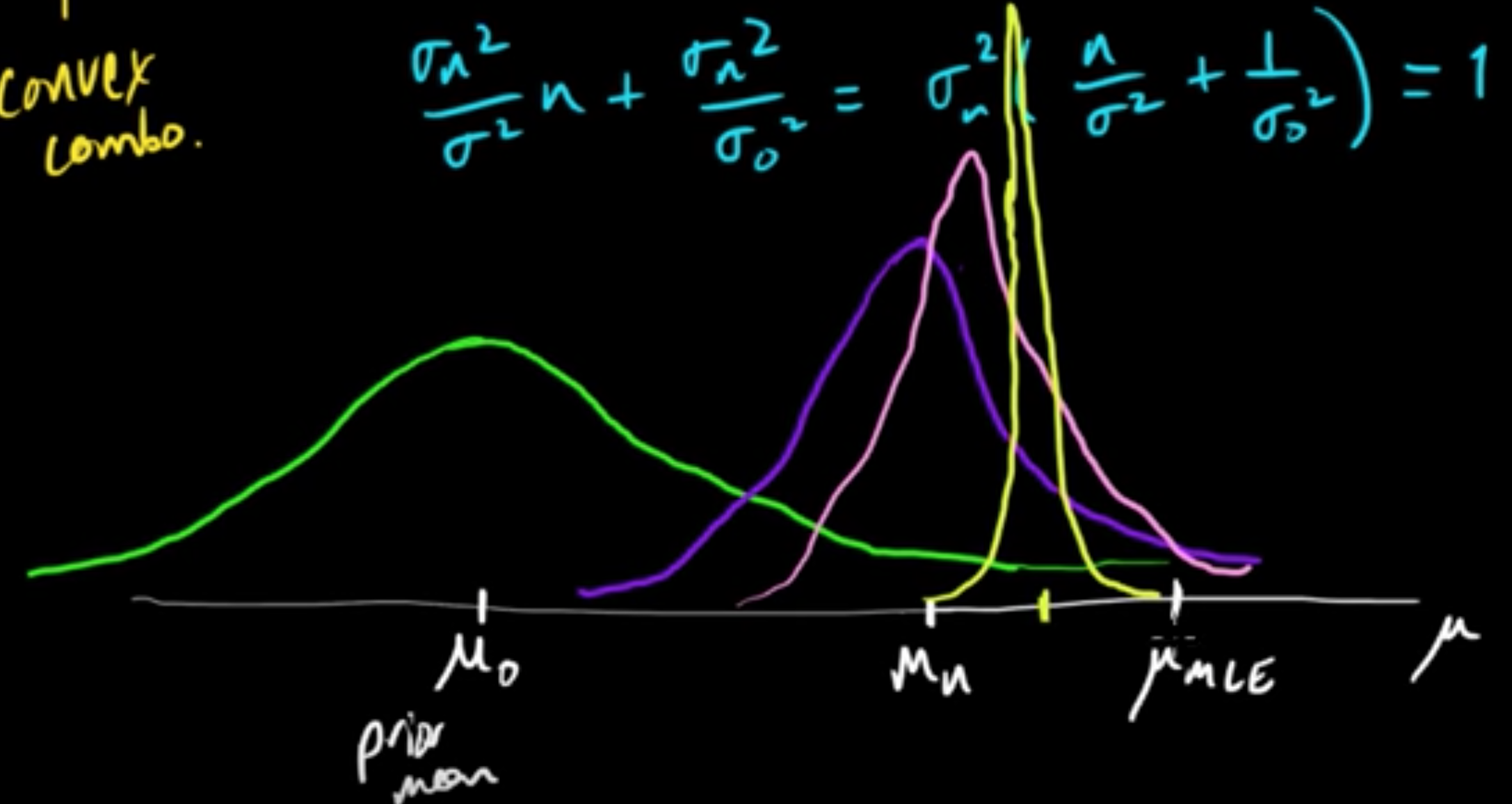
Subscribe via RSS
